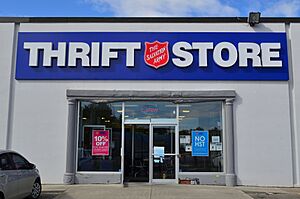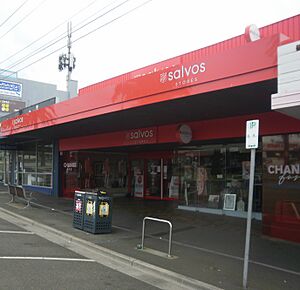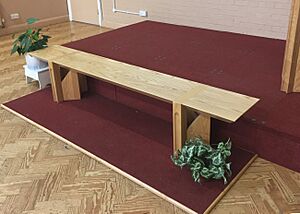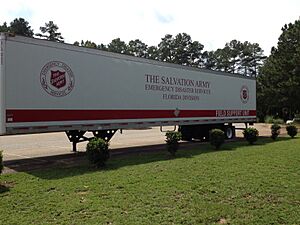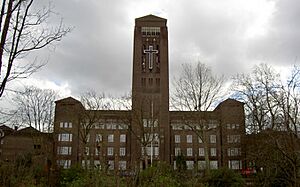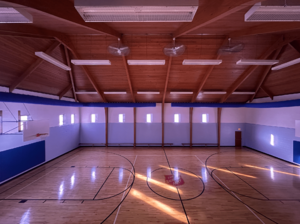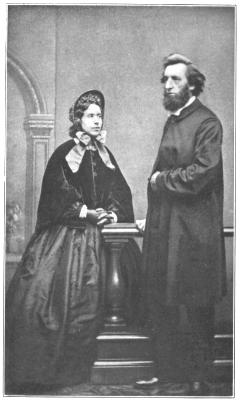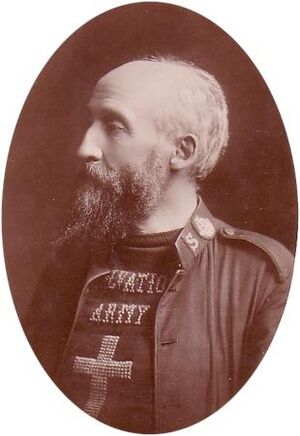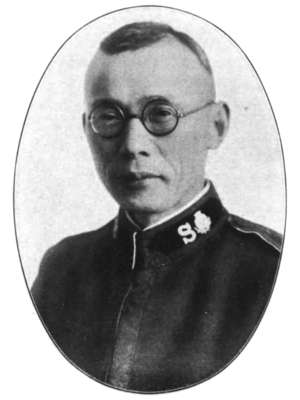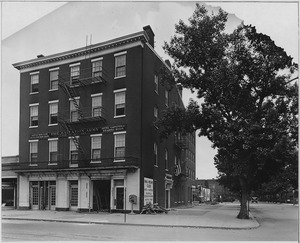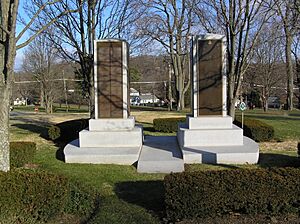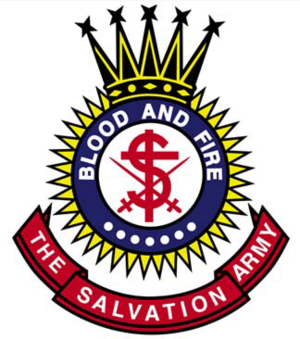The Salvation Army facts for kids
Quick facts for kids The Salvation Army |
|
|---|---|
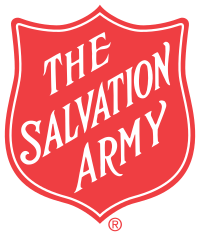 |
|
| Classification | Protestant |
| Orientation | Holiness movement |
| Scripture | Bible |
| Structure | Military rank-based chain of command |
| General | Lyndon Buckingham |
| Region | Worldwide |
| Headquarters | IHQ, London, EC4V United Kingdom |
| Founder | William and Catherine Booth |
| Origin | 2 July 1865 London |
| Separated from | Methodism |
| Separations | American Rescue Workers (1882) Volunteers of America (1896) |
| Congregations | 15,409 |
| Members | 1.65 million |
| Ministers | 26,359 |
| Other name(s) | East London Christian Mission (formerly) |
The Salvation Army (TSA) is a Christian church and a worldwide charity. Its main office is in London, England. It is part of the Protestant faith.
The Salvation Army has over 1.7 million members around the world. These members are called "Salvationists." The group was started to help poor, hungry, and homeless people. They wanted to help both their bodies and their spirits.
Today, The Salvation Army works in 133 countries. They run charity shops and shelters for people without homes. They also provide help during disasters and give aid to countries that need it.
The beliefs of The Salvation Army come from Methodism. However, they do not practice some traditional church rituals like sacraments. A special thing about The Salvation Army is that its leaders use military ranks. For example, they have "lieutenants" and "majors."
The Salvation Army was started in 1865. It was first called the "East London Christian Mission." It was founded by William Booth, a former Methodist preacher, and his wife Catherine Booth. In 1878, William Booth changed the mission into a military-style group. He became its first "general."
The Salvation Army is one of the biggest groups helping people in the United States and worldwide. In 2022, they spent a lot of money helping over 32 million people in the U.S. alone. They run feeding centers, shelters, and community centers. They also set up refugee camps, especially in Africa.
Contents
Leaders and Officers
The Salvation Army calls its church leaders "officers." You can often tell them apart by the special coloured epaulettes on their white uniforms. These epaulettes have a white letter "S" on them.
Officer ranks include:
- Lieutenant
- Captain
- Major
- Lieutenant Colonel
- Colonel
- Commissioner
- General
Officers usually move to new assignments every two to five years. This means they might move to different places, sometimes far away.
The Salvation Army allows women to become officers. In the past, officers could only marry other officers. This rule has changed in many places. Husbands and wives who are both officers often share the same rank. They also work together in the same roles, like leading churches or centers.
Places and Programs
The Salvation Army has many different buildings and programs to help people.
Churches and Community Centers
The Salvation Army has churches all over the world. These are called Salvation Army corps. They are used as both churches and places for the community. Some older corps buildings are also known as temples or citadels.
Thrift Stores
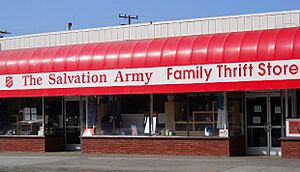

The Salvation Army is famous for its thrift stores. These stores sell used items like clothes, home goods, and toys. They are called "the Sally Ann" in Canada and the U.S. In Australia, they are "Salvos Stores." The money raised helps fund their programs.
When you buy things at these stores, some of the money goes to help people in need. Clothes that don't sell are recycled. The Salvation Army also helps people by giving jobs to those who have had trouble in the past. They believe in giving people a second chance.
Adult Rehabilitation Centers
Some Salvation Army places have Adult Rehabilitation Centers (ARCs). These centers help adults who want to make big changes in their lives. People live and work at the ARC for about six months. They get a place to stay and food. They also attend classes and special meetings to help them. This work is called "work therapy."
Hadleigh Farm Colony
The Salvation Army once had a farm colony in Hadleigh, Essex, England. This farm helped people from crowded city areas. It taught them farming skills and building trades. By 1912, thousands of people had been trained there. Most of them found jobs afterward.
Other Facilities
The Salvation Army also runs summer camps for kids and day care centers for adults. They have offices around the world. Other places they run include:
- Shelters for people without homes
- Homes for children
- Homes for older people
- Hospitals
- Schools
- After-school programs
- Food pantries
- Warming and cooling stations
What The Salvation Army Believes
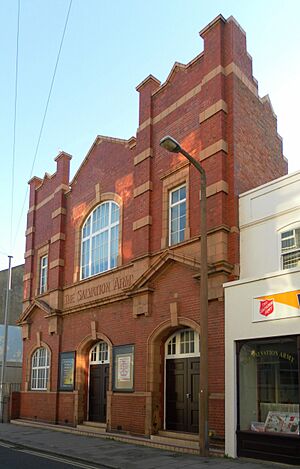
The Salvation Army's main goal is: "The Salvation Army, a worldwide movement, is a Christian church. Its message comes from the Bible. Its work is driven by God's love. Its goal is to share the good news of Jesus Christ and help people in His name without judging anyone."
The main book of the Salvation Army is the Bible. Their beliefs are based on eleven key ideas:
- They believe the Bible was inspired by God and guides Christian faith.
- They believe there is only one perfect God who created and rules everything.
- They believe God is three persons: the Father, the Son (Jesus), and the Holy Spirit.
- They believe Jesus Christ is both fully God and fully human.
- They believe that all people have become sinners.
- They believe Jesus died to save everyone who believes in Him.
- They believe turning to God, having faith in Jesus, and being born again by the Holy Spirit are needed for salvation.
- They believe people are made right with God through faith in Jesus.
- They believe staying saved means continuing to obey Christ.
- They believe all believers can become completely pure and blameless.
- They believe in life after death, the resurrection of the body, a final judgment, and eternal happiness for the good.
The Salvation Army does not practice rituals like Baptism or Holy Communion. They believe God's grace is always available everywhere. However, Salvationists can take Holy Communion if they attend a service at another Christian church that allows it.
They also believe that marriage was not started by Jesus, so it is not a sacrament. A special place in their churches is the "mercy seat." It is a place where anyone can kneel and pray to God.
Worship Services
Anyone can attend a Salvation Army church service. Services usually include:
- A welcome from the leader.
- Singing hymns with music.
- Reading from the Bible.
- Prayers led by the minister.
- Sometimes, a Sunday School for children.
- A collection for donations.
- Singing the doxology.
- A talk (sermon) about the Bible reading.
- A closing blessing.
Churches often sing modern worship songs along with traditional hymns. Music is often played by a brass band.
Soldier's Covenant
The Soldier's Covenant is like a promise that members of The Salvation Army make. It used to be called the "Articles of War." Everyone who wants to become a "Soldier" (a full member) signs this promise. It says they accept God's salvation and promise to love, serve, worship, and obey God.
Official Statements
The Salvation Army has official statements about social issues. For example, they are against the death penalty. They believe all human life is special.
In 2017, The Salvation Army made a statement against racism. They said racism is wrong because all people are made in God's image and are equal. They believe different cultures make the world better.
Helping Communities
Disaster Relief
The Salvation Army helps people during disasters. They first started helping in big ways after the 1900 Galveston hurricane and the 1906 San Francisco earthquake in the U.S.
They are a non-government group that provides aid. After the 2004 Indian Ocean tsunami, they helped find and bury the dead. They also helped rebuild homes and boats. They helped after hurricanes like Hurricane Katrina and Hurricane Rita. They also helped earthquake victims in Indonesia.
After Hurricane Katrina, The Salvation Army gave over $365 million to help more than 1.7 million people. They provided millions of hot meals, sandwiches, and drinks. Their special radio network (SATERN) helped find over 25,000 survivors. They also offered comfort and support to many people.
The Salvation Army was one of the first groups to help after the September 11 attacks in New York City in 2001. They also prayed with families of missing people.
Around the world, The Salvation Army has mobile vehicles called "canteen units." These units provide food and help to emergency workers and people affected by fires, floods, and other emergencies. Volunteers and officers run these services.
Family Tracing Service
The Family Tracing Service helps people find family members they have lost touch with. This service started in 1885. It is now available in most countries where The Salvation Army works. They help thousands of people reconnect with their relatives each year.
Youth Groups
The Salvation Army has many groups for young people. These include Sunday schools and Scout and Guide groups. These groups teach young people about Christian faith.
In the United States, there are special groups for girls: Girl Guards (older girls) and Sunbeams (younger girls). Boys can join Adventure Corps, which is for school-aged boys.
Alove UK
In the United Kingdom, The Salvation Army created a group called Alove. It is for young people to express their faith in their own ways. Its goal is to encourage young people to have strong faith, live a good life, and work for justice.
Work Against Exploitation
The Salvation Army works with groups like the UK's Modern Slavery Helpline. They help people who have been forced to work or have been used for profit. They also help homeless people by running shelters and refugee programs.
COVID-19 Relief
In 2020, during the COVID-19 pandemic, The Salvation Army helped a lot. In the United States, they gave out over 224 million meals. They also provided over 1.8 million kits with protective gear.
History of The Salvation Army
The Salvation Army began in London's East End in 1865. It was started by William Booth, a former minister, and his wife Catherine Booth. It was first called the "East London Christian Mission."
In 1878, William Booth changed the name to "The Salvation Army." He wanted it to be like an army fighting against sin and poverty. He became the "General." His other leaders became "officers," and members became "soldiers." They wore uniforms and sang hymns.
Catherine Booth was known as the "Mother of The Salvation Army." William focused on helping poor Londoners. Catherine spoke to richer people to get money for their work. She also preached, which was unusual for women at that time.
William Booth described their work with "the three 'S's': first, soup; second, soap; and finally, salvation." This meant they helped people with food, cleanliness, and their spiritual needs.
In 1880, The Salvation Army started work in Australia, Ireland, and the United States. The first official officers went to the U.S. in 1880. They found groups of Salvationists already helping people.
In 1891, William Booth started a farm colony in Hadleigh, Essex. This farm helped people escape crowded city slums. It taught them skills like building and farming.
The Salvation Army first helped people who were not welcome in other churches. The Booths did not use sacraments like baptism. They believed people relied too much on these signs instead of on God's grace. Members of The Salvation Army also do not drink alcohol, smoke, or gamble. Their soldiers wear uniforms that look different in different countries.
As The Salvation Army grew, some people in England did not like them. Groups called the Skeleton Army tried to stop their meetings. They threw things and attacked members. This often happened because pub owners were losing business since The Salvation Army was against alcohol.
The Salvation Army spread to Asia, starting in India in 1882. They also went to Japan in 1895 and China in 1915.
In the U.S., The Salvation Army became well-known for helping after the 1900 Galveston hurricane and the 1906 San Francisco earthquake.
Today, during Christmas, over 25,000 volunteers ring bells next to red kettles outside stores. They collect donations for the charity. The Salvation Army was also one of the groups that formed the USO during wartime.
History of Doughnut Day
In 1917, during World War I, over 250 Salvation Army volunteers went to France. They brought supplies and baked goods, including doughnuts, to soldiers. The women who made the doughnuts were called "Doughnut Lassies." They fried the doughnuts in soldiers' helmets! They helped make doughnuts popular in the United States.
Now, National Doughnut Day is celebrated every year on the first Friday of June. This tradition started in Chicago in 1938. It honors those who served doughnuts to soldiers during World War I.
In 1911, a yacht was given to The Salvation Army in New York City. This boat was called The Jerry McAuley. It was the first boat in the "Salvation Navy" in America. Its goal was to travel along the Atlantic coast. It did missionary work among sailors in different ports.
How The Salvation Army is Organized
The Salvation Army works in 133 countries. The General is the main leader. The organization is divided into five large areas: Americas and Caribbean, Europe, South Asia, South Pacific and East Asia, and Africa. The main office is in London, United Kingdom.
Each large area is then divided into smaller "territories." These territories are divided into "divisions." Some territories cover several countries. Other countries might have several territories. Each territory has a main office called "territorial headquarters" (THQ). Each division has a "divisional headquarters" (DHQ). A "territorial commander" leads each territory.
Heritage Centers
Heritage Centers are like museums run by The Salvation Army. They have old items and documents about the group's history and work. They collect, keep, and share information about The Salvation Army. The International Heritage Centre in London can provide details about places in any territory.
Membership Numbers
In 2018, The Salvation Army had:
- 111,859 employees
- 17,168 active officers
- 9,775 retired officers
- 1,050 cadets (officers in training)
- 175,811 "adherents" (people who attend but are not full soldiers)
- 411,327 "Junior Soldiers" (young members)
- 1,182,100 "Senior Soldiers" (adult members)
Leadership
General Lyndon Buckingham became the world leader of The Salvation Army on August 3, 2023.
International Congress
The International Congress of The Salvation Army is a big meeting for all Salvationists from around the world. It usually happens every ten years. The first one was in London in 1886. The most recent one was in London in 2015. This meeting celebrated 150 years since The Salvation Army started.
Presence in Russia and China
The Salvation Army started in Russia around 1917. It faced many challenges there. In 2006, a court ruled that a decision to expel them was illegal. Today, Russia is part of The Salvation Army's Eastern Europe Territory.
William Booth wanted The Salvation Army to be in China. The first officers were sent there in 1915. During a famine in 1931, they fed 100,000 people every day. Due to political problems, The Army left China in 1952. However, their work continues in Macau, Hong Kong, and Taiwan.
Symbols of The Salvation Army
Flag
The Salvation Army flag shows their fight against sin and social problems.
- The red on the flag means the blood of Jesus Christ.
- The yellow means the fire of the Holy Spirit.
- The blue means purity and God.
Crest
The crest is the oldest official symbol of The Salvation Army. It was designed in 1878. The crest has many symbols:
- The sun's rays mean the light and fire of the Holy Spirit.
- The cross means Jesus' cross, where He died for sins.
- The letter "S" means salvation, which is for everyone through Jesus.
- The crossed swords mean God's Word, which is a Christian's weapon against evil.
- The seven "Gospel shots" mean the basic truths of the Christian message.
- The words "Blood and Fire" are the Army's "war cry." Jesus' blood cleanses from sin, and the Holy Spirit makes people pure.
- The crown means the "Crown of Life and Glory" that God gives to those who are faithful.
Red Shield
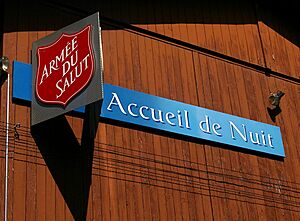
The Red Shield symbol started during wartime. In the late 1800s, Salvation Army officers helped British troops in the Boer War. In World War I, "Doughnut Girls" served food to soldiers. They also provided first aid, chaplaincy, and social clubs.
This symbol is now used a lot by The Salvation Army. It is a simple way to recognize them. You often see the Red Shield on casual Salvation Army uniforms. In the U.K., the Red Shield is now the main symbol used outside buildings.
Uniform
Salvation Army officers, trainees, and soldiers often wear uniforms. The idea came from a member in 1878 who wanted clothes that showed he was ready for "war to the teeth and salvation for the world." The uniform shows that the wearer is a Salvationist and a Christian. It also means they are ready to help people in need.
The uniform looks different in various countries. It always has an "S" symbol for "Salvation." This "S" means "Saved to Serve" or "Saved to Save." Different colours and styles show different ranks.
The uniform changes based on rank:
- Soldier: Plain black shoulder patches with an "S."
- Cadet (trainee): Black shoulder patches with red bars.
- Lieutenant: Red shoulder patches with one silver star and a red "S" patch.
- Captain: Red shoulder patches with two silver stars and a red "S" patch.
- Major: Red shoulder patches with a silver crest and a red "S" patch.
Tartan
Since 1983, The Salvation Army has an official Scottish tartan. It was designed in Scotland and uses the colours of the Salvation Army flag. It is not often seen outside Scotland.
Salute
The Salvation Army has a special salute. You raise your right hand above your shoulder with your index finger pointing up. It means you recognize a fellow Christian. It also means you promise to help others get to heaven. When a Salvationist salutes after applause, it means they give glory to God, not themselves. Sometimes, they also shout "hallelujah!"
Red Kettles
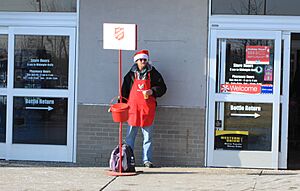
In many countries, people know The Salvation Army during Christmas time. Volunteers stand outside stores, sing carols, or ring bells. They collect money in red kettles. Sometimes, people anonymously put gold coins or large amounts of money into the kettles. This tradition started in 1982. Red kettles are also used at other times, like on National Doughnut Day. Each local church has a goal for how much money they want to collect.
Red Shield Appeal
The Red Shield Appeal is a yearly fundraising event in some countries, like the U.K. and Australia. Officers, soldiers, and volunteers go out to collect money from people. The money helps fund The Salvation Army's social work in that country. In the U.K., it is also called "The Big Collection."
Music Playing
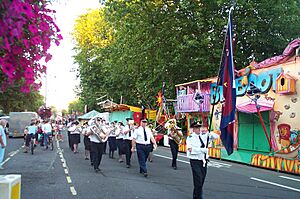
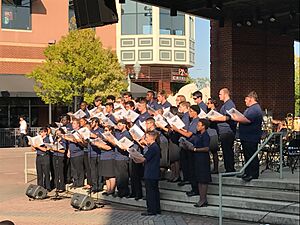
When The Salvation Army first started, they used music to attract crowds. A family of musicians helped them by playing music. This grew into the tradition of having brass bands. These bands are still seen in public at events, parades, and at Christmas.
The brass band is a well-known symbol of The Salvation Army. They also have choirs called Songster Brigades. The International Staff Songsters (ISS) is a famous choir. The International Staff Band is a very skilled brass band. Many Salvation Army churches have brass bands that play during meetings.
The Salvation Army uses music to connect with people. In the 1960s, their pop group, The Joystrings, was very popular in the U.K. Another band, The Insyderz, was popular in the 1990s. Many other bands continue this tradition today. The Salvation Army also uses tambourines with colourful ribbons. These are mostly played by women.
Public Opinion
In 1994, a study found that The Salvation Army was the 4th "most popular charity" in America. About 47% of Americans over 12 years old said they "Loved" or "Liked A Lot" The Salvation Army.
Honors
The "Order of the Founder" award was started in 1917. It is given to people who have done great service for The Salvation Army. The "Order of Distinguished Auxiliary Service" was started in 1941. It thanks non-members who have helped the organization.
In Films
The Salvation Army has been shown in many movies, like Guys and Dolls and Major Barbara. A book lists over 500 films where The Salvation Army appears.
The Salvation Army even had its own film studio called The Limelight Department in Australia. It started in 1892 and was the first film studio in Australia. They made over 300 films between 1898 and 1909. One film showed Australia's Federation Ceremonies.
|
See also
 In Spanish: Ejército de Salvación para niños
In Spanish: Ejército de Salvación para niños


